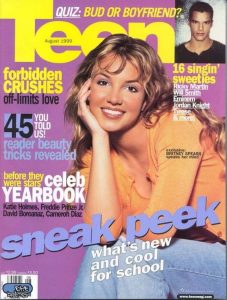“The Sassy, Sexy Young Women of Pop.”Cosmopolitan, vol. 211, no. 5, 11, 1991, pp. 182-185.
The 1991 article of Cosmopolitan Magazine titled “The Sassy, Sexy Young Women of Pop” displays multiple images of female pop singers of the late 1980’s and early 1990’s and their successes through short quotes and descriptions of each woman. The first page shows Mariah Carey kneeling, staring at the camera with a sentence in the middle of the page stating, “Of course they can sing, but in these days of MTV, looks, dazzle, sensuality, also help with stardom!” The article uses sexist language to depict each woman along with sexualized images of each singer. Referring to Sheena Easton as “Bombshell Sheena” and using an image of Easton in a tight red dress bending over, the short description of her does not mention her musical success or anything related to music, but shares a quote where she talks about wanting to have a baby with a popular news anchor at the time, Peter Jennings. The article was published during the boom of the pop music era, a time when female musicians and girl groups were releasing music centered on womanhood, independence and sexual agency. The Cosmopolitan article demonstrates that despite these developments, the sexualization of female singers, the focus put on their bodies and their utility as women, rather than their musical accomplishments, persists. Despite the milestones that women in music have made and the obstacles endured over the centuries, female singers and groups are continually being represented by their bodies, not their music.
TLC’s performance of “No Scrubs” at the 1999’s VMA’s
TLC’s 1999 performance of “No Scrubs” at the Video Music Awards illustrates the agency and self-awareness that women held over themselves and each other to not be with a guy that doesn’t deserve them, aka a “scrub”. The video opens with a conversation between an unknown male voice and a member of TLC, where the man yells “Hey, hey excuse me miss, can I talk to you for a minute, baby?” and she responds by yelling back “Who you callin’ baby?” The man answers with “You, baby!” to which she replies, “No, no, no, no I’m not hearing talk of me because I don’t want no scrubs!” [1]. With their performance, TLC highlights a common instance of street harassment that many women face, responding to the event with a strong pop anthem empowering women to be cognizant of what they deserve in a partner and self-ruling with their sexual agency. The performance ends with a fight scene between TLC and the female dancers on stage “fighting” against the male dancers on stage, with the women “defeating” the men in the end. The performance, which was broadcasted to an audience of almost twelve million viewers, emphasizes the influence that girl groups had on societal notions of womanhood and feminism [2]. In a time period where girl groups were becoming well-known and acknowledged in the music industry, TLC shares a message of independence and sisterhood between women, calling for women to claim what they want, and demanding men to listen.
Britney Spears on the cover of Teen magazine, 1999

Teen-pop music became popular in the late 1990’s with the rise of young stars like Britney Spears, who emulated many of the recurrent features of the idealized woman, but who’s music centered on notions of independence, power, and self-worth. On the cover of a 1999 issue of Teen magazine, Spears is seen wearing blue jeans and an orange blouse, with her hair down and a small amount of makeup on. Spears represents the young, up-and-coming stars of pop that are both naturally beautiful and talented. Spears,who grew to fame in the late 1990’s and into the 2000’s, encapsulated the rise in the autonomy of young, teenage women, who were starting to build careers in all fields and start becoming successful from an early age, a trend that continued onto the 2000’s into today.
[1] (0:16-0:28) [2] TV By the Numbers, “Historical Nielsen Ratings for MTV’s ‘Video Music Awards’ 1994-2009,” https://tvbythenumbers.zap2it.com/reference/historical-nielsen-ratings-for-mtvs-video-music-awards-1994-2009/, (September 12, 2010).
